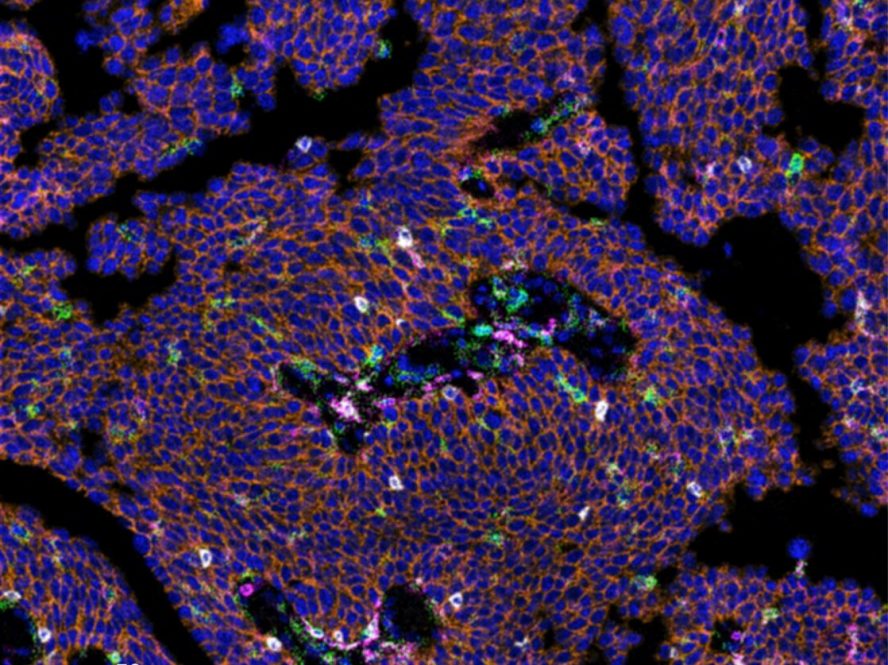The UConn Center on Aging, directed by Dr. George Kuchel, is the lead institution for a transformative NIH Common Fund U54 Tissue Mapping Center (U54AG075941) which is part of the NIH SenNet Consortium. SenNet stands for Senescence Network.
This new Center, which was awarded $13.5 million in NIH-funding, is already mapping senescent cells found in human tissues with a particular focus on kidney, adipose, pancreatic, and placental tissues, hoping to discover why these abnormal cells stop dividing and begin causing aging and chronic disease development.
On Dec. 20, 2022 in the journal Nature Aging a paper published to present the SenNet Consortium collaboration of institutions from throughout the United States: “NIH SenNet Consortium: Mapping the landscape of senescent cells throughout the human lifespan to understand physiological health.”
Investigators at UConn and JAX are receiving a robust pipeline of tissue samples from nationwide surgery and transplant centers, analyzing and cataloging them, and posting the results to the NIH databases.
Although much work has been done using cultured cells and animal models, little is known about how senescent cells accumulate and behave in human tissues. Not only will the SenNet Consortium develop detailed maps of varied senescent cells within different tissues, but this information will help guide ongoing and future clinical trials designed to eliminate senescent cells in humans using drugs called senolytics. These novel approaches have the potential for transforming our ability to enhance function and independence of older adults by targeting chronic conditions of aging as varied as frailty, heart disease, osteoporosis and Alzheimer’s disease.
“This is a big deal for the future of clinical medicine. For the first time this effort will allow the identification of senescent cells in healthy human tissues opening the avenue for transformative clinical therapies,” says Kuchel, the Principal Investigator for the NIH Common Fund U54 Tissue Mapping Center at UConn Health/JAX.
“We are mapping each senescent component to more thoroughly understand how they work, and in time, we will develop medicines that will limit their negative effects and accentuate their positive properties,” says Kuchel.
Nationally, SenNet is a trans-NIH effort managed collaboratively by staff from the NIH Common Fund, the National Institute on Aging (NIA), and the National Cancer Institute (NCI). SenNet will collect and analyze 18 tissues overall from healthy humans across lifespan with four of these tissues (kidney, adipose, pancreas, and placenta) as the target tissues of the KAPP-Sen Tissue Mapping Center (KAPP-Sen TMC), led by Kuchel, M.D., at the UConn Center of Aging with co-PIs Professor Paul Robson, Ph.D., of The Jackson Laboratory (JAX), Vesna Garovic, M.D., Ph.D. (Mayo Clinic), and Nicolas Musi, M.D. (University of Texas Health Science Center at San Antonio).
Robson’s lab leads the Biological Analysis Core, and the Data Analysis Core of KAPP-Sen TMC is led by JAX Associate Professor Duygu Ucar, Ph.D., and JAX Professor Jeff Chuang, Ph.D. Moreover, Ming Xu, PhD and his colleagues in the UConn Center on Aging are involved in the analysis of senescent cells within adipose tissues, while Qian Wu, MD, PhD in the Department of Pathology and Laboratory Medicine at UConn Health will evaluate tissue histopathology.
In addition, SenNet has also grown over the past year to add mouse-focused investigators, and JAX was designated as a Tissue Mapping Center (TMC) for SenNet in August 2022, supported by a four-year, $10.7 million grant from the National Institute on Aging. JAX-Sen is led by Professor and Maxine Groffsky Endowed Chair Nadia Rosenthal, Ph.D., FMedSci with co-principal investigators Robson, JAX Associate Professor Ron Korstanje, Ph.D., and UConn Health’s Ming Xu, Ph.D. Associate Professor Sheng Li and Principal Computational Scientist Matt Mahoney lead the Data Analysis Core of the JAX-Sen TMC.



